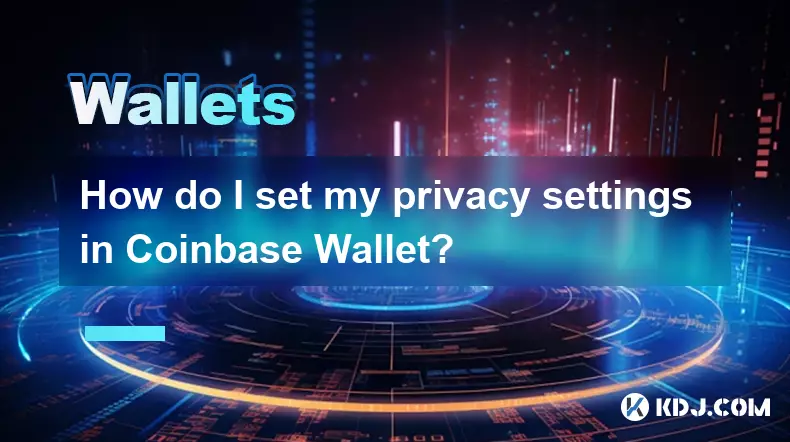-
 bitcoin
bitcoin $114779.865156 USD
2.30% -
 ethereum
ethereum $4226.519789 USD
2.39% -
 tether
tether $1.000545 USD
0.04% -
 xrp
xrp $2.890223 USD
0.92% -
 bnb
bnb $1030.029301 USD
2.95% -
 solana
solana $212.824944 USD
1.69% -
 usd-coin
usd-coin $0.999757 USD
0.01% -
 dogecoin
dogecoin $0.234961 USD
-0.27% -
 tron
tron $0.337174 USD
0.42% -
 cardano
cardano $0.804783 USD
0.09% -
 hyperliquid
hyperliquid $45.748770 USD
-2.85% -
 chainlink
chainlink $21.699170 USD
0.82% -
 ethena-usde
ethena-usde $1.001452 USD
0.08% -
 avalanche
avalanche $30.237800 USD
1.14% -
 stellar
stellar $0.372604 USD
1.52%
How do I set my privacy settings in Coinbase Wallet?
Enhance privacy in Coinbase Wallet by disabling metadata fetching, hiding small balances, using ENS names, and revoking unused dApp permissions to protect your data and funds.
Sep 27, 2025 at 03:01 am

Understanding Privacy Controls in Coinbase Wallet
1. Open the Coinbase Wallet application on your mobile device and navigate to the main dashboard. Locate the settings icon, typically found in the upper right or within a side menu drawer. This section houses all customizable features, including privacy configurations.
2. Within the settings menu, select 'Privacy' to access specific controls related to data visibility and transaction anonymity. Here, users can toggle options such as hiding small balances, enabling private browsing mode, and managing biometric authentication for added security.
3. To enhance anonymity during transactions, ensure that domain name resolution is disabled when interacting with decentralized applications (dApps). The wallet automatically blocks known tracking domains, but manual verification strengthens protection against potential leaks of browsing behavior.
4. Users have the ability to disable transaction history syncing across devices by turning off cloud backup for wallet data. This ensures that sensitive financial activity remains isolated to the primary device, reducing exposure to unauthorized access through linked accounts.
5. Adjust notification preferences to limit the amount of detail displayed on lock screens. Sensitive information like token names or transfer amounts should be hidden to prevent shoulder surfing or unintended disclosure in public environments.
Securing Your Seed Phrase and Identity
1. Never store your 12-word recovery phrase digitally unless encrypted with a trusted password manager. Physical storage on metal backup plates offers superior resistance against fire, water, and digital theft.
2. Avoid sharing any part of your seed phrase, even with support personnel claiming affiliation with Coinbase. Legitimate teams will never request this information under any circumstance.
3. Enable local encryption for wallet files if the operating system supports it. On iOS, use Face ID integration; on Android, leverage built-in file-based encryption to protect stored keys from physical tampering.
4. Regularly audit connected dApps through the browser tab in Coinbase Wallet. Revoke permissions for services no longer in use to minimize attack surfaces created by excessive smart contract approvals.
5. Consider using a secondary wallet for high-risk interactions such as testing new protocols or participating in early-stage token launches. Isolating experimental activity protects core holdings from unforeseen vulnerabilities.
Managing Token Visibility and Metadata
1. Navigate to the 'Tokens' tab and manually hide assets you do not actively trade. This reduces clutter and prevents accidental engagement with malicious tokens that mimic legitimate projects through similar naming conventions.
2. Disable automatic metadata fetching for unrecognized tokens. When enabled, this feature may expose IP addresses to third-party servers hosting logo images or contract details, potentially compromising network-level anonymity.
3. Use ENS (Ethereum Name Service) domains instead of raw wallet addresses when receiving funds. These human-readable names reduce errors and eliminate the need to share long hexadecimal strings that could be logged by intermediaries.
4. Review default RPC endpoints used for blockchain queries. Switching to privacy-focused nodes like Infura’s secure gateway or self-hosted providers limits metadata collection by centralized infrastructure operators.
Always verify contract addresses before adding custom tokens. Fake tokens with identical symbols often appear in user interfaces, leading to irreversible loss of funds when interacted with.Controlling Connectivity and Network Exposure
1. When accessing dApps through the integrated browser, assume all activity is monitored by the website operator. Avoid logging into personal accounts or entering identifiable information while connected to blockchain interfaces.
2. Clear browsing data regularly within the wallet’s internal browser. Cached sessions may retain login states or form inputs that expose behavioral patterns over time.
3. Limit Bluetooth and Wi-Fi sharing features when conducting transactions. Wireless channels can be exploited to intercept screen content or inject malicious scripts during active sessions.
4. Monitor background app refresh settings on mobile operating systems. Preventing Coinbase Wallet from syncing data in the background reduces opportunities for silent data transmission to external servers.
Never connect your wallet to untrusted websites or phishing pages mimicking popular platforms. Always double-check URLs and SSL certificates before approving any wallet interaction.Frequently Asked Questions
Can I use a VPN with Coinbase Wallet to improve privacy?Yes, using a reputable VPN encrypts internet traffic between your device and the blockchain node. This obscures your IP address from service providers handling transaction broadcasts, enhancing network-layer confidentiality.
Does Coinbase Wallet track my transaction history?Coinbase Wallet does not centrally log transaction data. All records are stored locally on your device. However, interactions with dApps may be visible to those services, so review their privacy policies before connecting.
How do I remove a compromised dApp connection?Go to Settings > Connected Apps, find the suspicious application, and tap 'Revoke.' This action terminates its access to your wallet address and prevents further unauthorized contract calls.
Is it safe to enable facial recognition on my wallet?Biometric authentication adds a layer of physical security. As long as your device itself is secured and not jailbroken, Face ID or fingerprint locks provide strong protection against casual access attempts.
Disclaimer:info@kdj.com
The information provided is not trading advice. kdj.com does not assume any responsibility for any investments made based on the information provided in this article. Cryptocurrencies are highly volatile and it is highly recommended that you invest with caution after thorough research!
If you believe that the content used on this website infringes your copyright, please contact us immediately (info@kdj.com) and we will delete it promptly.
- Government Shutdown, Trump Meeting, Deadlock: A New Yorker's Crypto Take
- 2025-09-30 10:45:12
- Token Securities, Stablecoins, and Synergy: A New Standard for Digital Finance in NYC
- 2025-09-30 10:25:15
- Dogecoin, Shiba Inu, and Remittix: Decoding the Crypto Hype
- 2025-09-30 10:25:15
- Bitcoin Surge: Bullish Factors and Seasonal Trends Fueling the Rally
- 2025-09-30 10:45:12
- Binance Coin Breakout: Riding the Cryptocurrency Wave
- 2025-09-30 10:50:01
- Bitcoin, Corporate Treasury, and Fintech Startups: A New Era of Finance
- 2025-09-30 10:50:01
Related knowledge

How do I view smart contract interaction history in Coinbase Wallet?
Sep 24,2025 at 01:36am
Accessing Smart Contract Interaction History in Coinbase Wallet1. Open the Coinbase Wallet application on your mobile device and log in using your cre...

How do I use the token swap feature in Coinbase Wallet?
Sep 24,2025 at 05:00pm
Understanding Token Swaps in Coinbase Wallet1. The token swap feature in Coinbase Wallet enables users to exchange one cryptocurrency for another dire...

How do I participate in governance voting in Coinbase Wallet?
Sep 25,2025 at 01:55pm
Understanding Market Volatility in the Crypto Space1. Cryptocurrency markets are known for their extreme price fluctuations, often driven by sentiment...

How do I set up a custom RPC node in Coinbase Wallet?
Sep 24,2025 at 12:00pm
Understanding Custom RPC Nodes in Coinbase Wallet1. A custom RPC (Remote Procedure Call) node allows users to connect their Coinbase Wallet to a block...

How do I clear cached data in Coinbase Wallet?
Sep 30,2025 at 10:36am
Clearing cached data in Coinbase Wallet helps improve performance and resolve common app issues such as slow loading or syncing errors. Understanding ...

How do I manage multiple assets in Coinbase Wallet?
Sep 23,2025 at 10:00am
Understanding Multi-Asset Support in Coinbase Wallet1. Coinbase Wallet allows users to store a wide variety of digital assets beyond just Bitcoin and ...

How do I view smart contract interaction history in Coinbase Wallet?
Sep 24,2025 at 01:36am
Accessing Smart Contract Interaction History in Coinbase Wallet1. Open the Coinbase Wallet application on your mobile device and log in using your cre...

How do I use the token swap feature in Coinbase Wallet?
Sep 24,2025 at 05:00pm
Understanding Token Swaps in Coinbase Wallet1. The token swap feature in Coinbase Wallet enables users to exchange one cryptocurrency for another dire...

How do I participate in governance voting in Coinbase Wallet?
Sep 25,2025 at 01:55pm
Understanding Market Volatility in the Crypto Space1. Cryptocurrency markets are known for their extreme price fluctuations, often driven by sentiment...

How do I set up a custom RPC node in Coinbase Wallet?
Sep 24,2025 at 12:00pm
Understanding Custom RPC Nodes in Coinbase Wallet1. A custom RPC (Remote Procedure Call) node allows users to connect their Coinbase Wallet to a block...

How do I clear cached data in Coinbase Wallet?
Sep 30,2025 at 10:36am
Clearing cached data in Coinbase Wallet helps improve performance and resolve common app issues such as slow loading or syncing errors. Understanding ...

How do I manage multiple assets in Coinbase Wallet?
Sep 23,2025 at 10:00am
Understanding Multi-Asset Support in Coinbase Wallet1. Coinbase Wallet allows users to store a wide variety of digital assets beyond just Bitcoin and ...
See all articles










































































